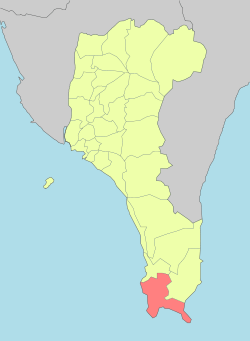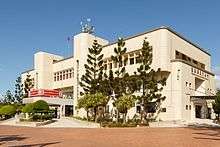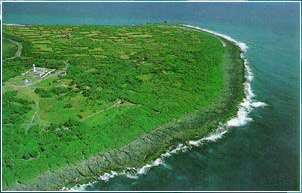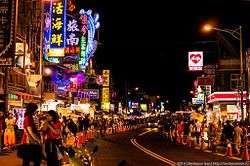Hengchun
| Hengchun 恆春 | |
|---|---|
| Urban township | |
| Hengchun Township · 恆春鎮 | |
|
Kenting Main Street (Kenting Night Market), Hengchun | |
 Hengchun Township in Pingtung County | |
| Country | Taiwan |
| Region | Southern Taiwan |
| Area | |
| • Total | 136.7630 km2 (52.8045 sq mi) |
| Population (December 2014) | |
| • Total | 30,859 |
| • Density | 230/km2 (580/sq mi) |
| Households | 10568 |
| Divisions | 17 villages, 272 neighborhoods |
| Postal code |
946 |
| Chinese name | |
| Traditional Chinese | 恆春鎮 |
| Literal meaning | Eternal Spring Town |
| Hanyu Pinyin | Héngchūn Zhèn |
| Pha̍k-fa-sṳ | Hèn-chhûn-chṳ́n |
| Hokkien POJ | Hêng-chhun Tìn |
| Website | www.hengchuen.gov.tw (in Chinese) |
Hengchun Township (Chinese: 恆春鎮) is an urban township located on the southern tip of the Hengchun Peninsula of Pingtung County, Taiwan. It is the southernmost township in Taiwan. Hengchun is also the only urban township in the southern part of Pingtung County. Hengchun has a land area of 136.76 square kilometres (52.80 sq mi) and has a population of 30,859 as of December 2014.
The city of Hengchun is the entry way to Kenting National Park, the southernmost National Park in the country. With pristine beaches and a vibrant tourist industry, the Hengchun area often attracts more travelers than local residents. The city itself was once completely surrounded by a city wall; now about half of the wall remains intact, as well as the four city gates. On weekends, the streets of nearby Kenting are filled with cars and tour buses.
The 2008 Taiwanese film Cape No. 7, the top-grossing film in Taiwan's film history, features Hengchun.
Etymology and names

Lonkjouw
The modern-day Hengchun area was known to the Dutch as Lonkjouw,[1] alternatively spelled Longkiau, Loncjou, Lonckjau, Lonckiau, Lonkiauw, Lonckjouw, and Lonckquiouw in early records.[2] The name was borrowed from the Paiwan language of the Paiwan people who lived in the area before the Han Chinese's colonization during 18th century.
Origin of the name "Hengchun"
After the 1871 Mudan Incident which took place near the southern tip of Taiwan, Qing government official Shen Baozhen made an address to the throne for building a city in Longkiau (Chinese: 瑯嶠; Pe̍h-ōe-jī: Lông-kiau) for foreign sailors to accommodate and protect them from the aboriginals' slaughtering. During the stay, Shen noticed that the climate of the area remained warm and sunny, with crops staying "green and wealthy" year-round, therefore he named it Hengchun (恆春; "Eternal Spring") before he left in 1875 and the term has been used to refer to the area since then.
Japanese rule
The area was known as Kōshun Town (Japanese: 恒春街), written using a simplified form of the name.[3]
History
During Dutch rule, the village of Liangkiau was the most southern area of importance that Dutch authority extended to.[4]
Qing dynasty rule
In 1867, American consul Charles Le Gendre wrote that Liang-kiau was located at the far point of the curve forming Liangkiau Bay,[5] and had a population of about 1,500 who were "mostly engaged in the culture of peanuts, rice, sweet potatoes, a little sugar cane, and also in fishing".[6] In retaliation for the 1871 murder of 54 Ryukyuan sailors by Paiwan aborigines, the Japanese launched a punitive expedition to Taiwan in 1874. Longkiau Bay was selected as the landing place for the Japanese force.[7] The expedition revealed the fragility of the Qing dynasty's hold on Taiwan and also paved the way for de facto Japanese incorporation of Ryukyu in 1879.
In 1875, Imperial commissioner Shen, who had been charged with making arrangements to prevent the Japanese from occupying Chinese districts, began introducing reforms in government. Hengchun District was created from the portion of Fongshan District south of a river slightly north of Pangliau.[8] A new town was founded to be the local seat of government by erecting walls around one of the villages.
When Fujian-Taiwan Province was declared in 1887, Hengchun District was under Tainan Prefecture.
Japanese rule
During Japanese rule, after November 1901, the Japanese government established a local office, or "Cho", in Kōshun (Hengchun).[9] Beginning in 1920, the town was administered as Kōshun Town (恒春街), Kōshun District, Takao Prefecture.
2006 Hengchun earthquake
On December 26, 2006, a 7.0–7.2 magnitude earthquake with an epicenter off the southwest coast of Taiwan occurred (approximately 22.8 km southwest of Hengchun). It caused damage to many houses in Hengchun, including fifteen historical buildings in the historic center of the township.[10] Two casualties were reported, with many more injured. It was the strongest earthquake to hit Hengchun in one hundred years.[11]
Climate
| Hengchun (2009-2013) | ||||||||||||||||||||||||||||||||||||||||||||||||||||||||||||
|---|---|---|---|---|---|---|---|---|---|---|---|---|---|---|---|---|---|---|---|---|---|---|---|---|---|---|---|---|---|---|---|---|---|---|---|---|---|---|---|---|---|---|---|---|---|---|---|---|---|---|---|---|---|---|---|---|---|---|---|---|
| Climate chart (explanation) | ||||||||||||||||||||||||||||||||||||||||||||||||||||||||||||
| ||||||||||||||||||||||||||||||||||||||||||||||||||||||||||||
| ||||||||||||||||||||||||||||||||||||||||||||||||||||||||||||
Hengchun is well known for its tropical monsoon climate with warm temperatures year round, the term "HengChun" literally means "Eternal Spring" in Chinese as Hengchun is known for having neither a cool winter nor an extremely hot summer, with average monthly mean temperatures ranging between 21 and 28 degrees Celsius. The climate is generally divided into two seasons, the cooler and drier season and the warmer and wetter season. During the cool and dry season from early December to late March of the following year, precipitation are relatively low with temperatures ranging from 18-26 Degrees Celsius, occasional cold fronts can drop both the day and the night time temperatures by around 2-4 °C, while temperatures during a clear sunny day can reach as high as 28-30 °C. During the warm and wet season temperature range from 24–32 degrees Celsius with a relatively abundant rainfall especially from May–October, when Taiwan is affected by the Pacific typhoon season.
Hengchun's spring like climate is very much dictated by its location surrounded by the ocean, resulting in a noticeably smaller difference between the day and night temperatures than most other townships of Pingtung. Hengchun is usually cooler than other townships in the county during daytime and warmer than others during the night, especially during the winter months, when daily lows usually hovers around 18-20 degrees Celsius at Hengchun and around 15-18 at Pingtung city, while daily highs usually hovers around 24-26 degrees Celsius at the township and 25-28 at Pingtung City. Temperatures dips below 15 degrees Celsius on average once every 3 years, mostly on early mornings of January when Taiwan is affected by a cold front.
The climate is also supportive of tropical rainforests (tropical monsoon rainforest) which occupied the entire Hengchun peninsula, while palm trees and other tropical vegetation grows on the coastlines, much like the rest of Pingtung.
| Climate data for Hengchun | |||||||||||||
|---|---|---|---|---|---|---|---|---|---|---|---|---|---|
| Month | Jan | Feb | Mar | Apr | May | Jun | Jul | Aug | Sep | Oct | Nov | Dec | Year |
| Record high °C (°F) | 33.1 (91.6) |
34.3 (93.7) |
34.5 (94.1) |
35.1 (95.2) |
36.4 (97.5) |
37.2 (99) |
37.1 (98.8) |
37.3 (99.1) |
36.2 (97.2) |
35.6 (96.1) |
34.5 (94.1) |
33.7 (92.7) |
37.3 (99.1) |
| Average high °C (°F) | 24.3 (75.7) |
25.4 (77.7) |
27.3 (81.1) |
29.4 (84.9) |
30.9 (87.6) |
31.4 (88.5) |
31.9 (89.4) |
31.6 (88.9) |
31.0 (87.8) |
29.7 (85.5) |
27.6 (81.7) |
25.0 (77) |
28.8 (83.8) |
| Daily mean °C (°F) | 20.7 (69.3) |
21.5 (70.7) |
23.2 (73.8) |
25.2 (77.4) |
27.0 (80.6) |
28.0 (82.4) |
28.4 (83.1) |
28.1 (82.6) |
27.4 (81.3) |
26.3 (79.3) |
24.4 (75.9) |
21.8 (71.2) |
25.2 (77.4) |
| Average low °C (°F) | 18.1 (64.6) |
18.8 (65.8) |
20.2 (68.4) |
22.3 (72.1) |
24.1 (75.4) |
25.4 (77.7) |
25.6 (78.1) |
25.3 (77.5) |
24.7 (76.5) |
23.9 (75) |
22.1 (71.8) |
19.4 (66.9) |
22.5 (72.5) |
| Record low °C (°F) | 8.4 (47.1) |
9.0 (48.2) |
10.1 (50.2) |
15.3 (59.5) |
18.2 (64.8) |
19.5 (67.1) |
21.1 (70) |
21.3 (70.3) |
20.6 (69.1) |
17.4 (63.3) |
15.1 (59.2) |
10.0 (50) |
8.4 (47.1) |
| Average rainfall mm (inches) | 17.3 (0.681) |
25.3 (0.996) |
20.3 (0.799) |
37.3 (1.469) |
166.4 (6.551) |
378.6 (14.906) |
388.4 (15.291) |
502.5 (19.783) |
323.0 (12.717) |
110.7 (4.358) |
54.9 (2.161) |
28.3 (1.114) |
2,053 (80.826) |
| Average rainy days (≥ 0.1 mm) | 8.0 | 6.8 | 4.8 | 6.3 | 11.1 | 16.9 | 16.4 | 18.9 | 15.9 | 10.8 | 7.1 | 6.1 | 129.1 |
| Average relative humidity (%) | 72.6 | 73.7 | 74.4 | 75.4 | 78.5 | 83.6 | 83.3 | 84.0 | 79.7 | 74.0 | 70.8 | 70.7 | 76.7 |
| Mean monthly sunshine hours | 168.0 | 165.1 | 199.7 | 192.6 | 193.9 | 183.6 | 221.0 | 195.5 | 177.2 | 198.1 | 177.7 | 161.4 | 2,233.8 |
| Source: Central Weather Bureau (Normals 1984-2013, Extremes 1961-present, Rain 1981-2014)[12][13] | |||||||||||||
Administrative divisions

The township comprises 17 villages: Chengbei, Chengnan, Chengxi, Daguang, Dehe, Eluan, Jiahu, Kending, Longshui, Nanwan, Renshou, Shanhai, Shanjiao, Shuiquan, Sigou, Tougou and Wangsha.
Education
Vocational High School
Middle School
Elementary Schools
- Hengchun Elementary School 屏東縣恆春鎮恆春國民小學
- Hengchun Elementary School - Nanwan Branch 屏東縣恆春鎮恆春國民小學南灣分校
- Chau Yon Elementary School 屏東縣恆春鎮僑勇國民小學
- Da Guang Elementary School 屏東縣恆春鎮大光國民小學
- Shan Hai Elementary School 屏東縣恆春鎮山海國民小學
- Swey Chuen Elementary School 屏東縣恆春鎮水泉國民小學
- Lung Chuen Elementary School 屏東縣恆春鎮龍泉國民小學
- Da Ping Elementary School 屏東縣恆春鎮大平國民小學
- Kenting Elementary School 屏東縣恆春鎮墾丁國民小學
- Er Lun Elementary School 屏東縣恆春鎮鵝鑾國民小學
Tourist attractions

Hengchun is located within the Kenting National Park and is the gateway to the tropical beach resorts and night markets of downtown Kenting, therefore it is also one of the most well known tourist towns in Taiwan, best known for the "Hengchun Old Town" (恆春古城). The "Hengchun Old Town" is one of the best-preserved historical towns in Taiwan with four gates intact and about half of the walls remaining. It was built during the 1st year of GuangXu's reign of the Qing dynasty in 1875 and completed in 1879. It has a north, east, south and west gate and the outer circumference of the moat measures 880 zhang (1 zhang equals 10 feet). In 1988, an actual measurement of the length was conducted, showing that the length in total amount to 2550 meters.
The peak season of tourism in Hengchun usually lasts from April to late October when daytime temperatures are usually hot, while the off season lasts from November to March of the following year, with the exception of the week of the Chinese New Year holiday which usually takes place during late January or February, when large amount of tourist from around the whole country, mostly from Northern Taiwan travels to Hengchun and Kenting for the peninsula's warm weather.
Festivals
- Pingtung Picturesque Rice Field Life Festival[14]
Transportation
The township is served by its Hengchun Airport, serving domestic flights from Taipei Songshan Airport in Taipei.
References
- ↑ Andrade, Tonio (2005). "Chapter 1: Taiwan on the Eve of Colonization". How Taiwan Became Chinese: Dutch, Spanish, and Han Colonization in the Seventeenth Century. Columbia University Press. Note 40.
The main villages of Lonkjouw were in the area of present-day Hengchun.
- ↑ Campbell, William (1903). "Explanatory Notes". Formosa under the Dutch: described from contemporary records, with explanatory notes and a bibliography of the island. London: Kegan Paul. p. 545. LCCN 04007338. OCLC 644323041.
- ↑ Governor-General of Taiwan (1931–1932). "hêng-chhun (恒春)". In Ogawa Naoyoshi. 臺日大辭典 [Taiwanese-Japanese Dictionary] (in Japanese and Hokkien). 2. Taihoku: 同府 [Dōfu]. p. 632. OCLC 25747241..
- ↑ Davidson (1903), p. 23.
- ↑ Davidson (1903), p. 118.
- ↑ Davidson (1903), p. 118-9.
- ↑ Davidson (1903), p. 126.
- ↑ Davidson (1903), p. 209.
- ↑ Davidson (1903), p. 597.
- ↑ 恆春古城 城倒15座, UDN, Taiwan, 2006-12-27 (in Chinese)
- ↑ 2 KILLED IN STRONGEST EARTHQUAKE IN HENGCHUN IN 100 YEARS, Central News Agency, Taiwan, 2006-12-27
- ↑ "Climate". Central Weather Bureau.
- ↑ "Climate". Central Weather Bureau.
- ↑ http://www.taipeitimes.com/News/taiwan/photo/2016/03/31/2008131066
Bibliography
External links
| Wikimedia Commons has media related to Hengchun. |
Coordinates: 22°00′N 120°45′E / 22.000°N 120.750°E



